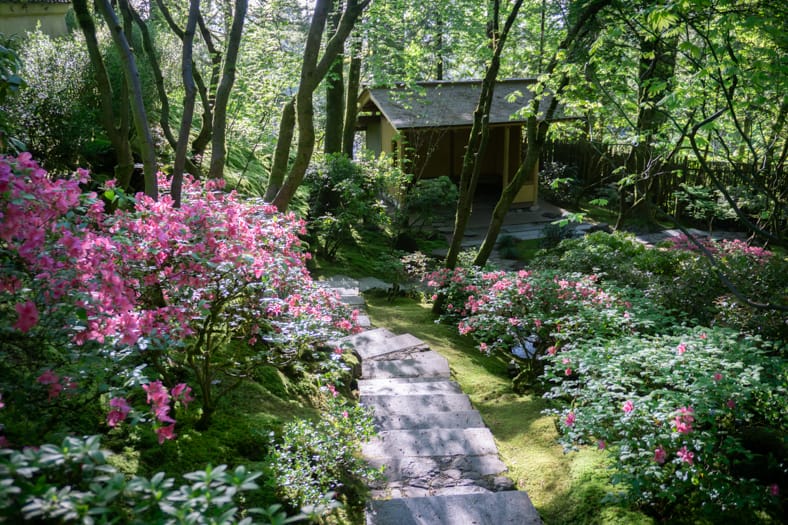The Natural Garden, one of the five historic garden spaces at Portland Japanese Garden will have sections closed in September and October to address a water leak at Saka’s Pond, a body of water near its entry. Saka’s Pond pays homage to Haichiro Sakakibara, Garden Director of Portland Japanese Garden from 1972 to 1974, who with help from his predecessor Hoichi Kurisu (1968-73), led the construction of the Natural Garden over the course of two winters. Sakakibara planted azaleas and pieris and created walkways and stairs using granite recycled from the old Portland Civic Auditorium (today, known as the Keller Auditorium). The pond was among his contributions and today is the third largest pond in our landscape.

Saka’s Pond is a beautiful space with flowers that radiate pink in springtime, a pleasant waterfall, and a “carp stone,” a humpbacked stone that evokes a tale from folklore about a fish that swam upstream and transformed into a mighty dragon. However, Saka’s Pond was built on the edge of a slope, which is causing some issues. Due to its placement, its foundation has been undermined and has subsequently seen a loss of water. The leaks, in turn, are further undermining the foundation and causing the slope to erode even more. Altogether, the eroding slope, faulty foundation, and loss of water means repairs are in order.
How are we repairing Saka’s Pond? In September and October, we’re going to:
- Remove boulders surrounding it—some weigh as much as 600 pounds!
- We’re going to gently remove the plants around the pond.
- We’ll then redesign the foundation—the pond is going to get a bit slimmer, keep its edge further away from the edge of the slope.
When we’re all done, it’s going to look like this sketch by our Garden Curator, Hugo Torii:

The Natural Garden, like all of Portland Japanese Garden, may appear to be still, but in reality, the land is constantly moving—trees sway in wind, water babbles in streams, and the earth is constantly adjusting underneath our feet. Because nature never takes a pause, it is our work to understand the landscape, be aware of how it’s everchanging, and recognize when it’s our time to step in and rehabilitate it. We regret having to close this part of the Garden—thank you for your understanding! The work we do now means the Natural Garden will be enjoyed for generations to come.
To keep up-to-date with our repairs, sign up for our free weekly newsletter:
More About the Natural Garden

Portland Japanese Garden’s historic garden spaces each represent a different era from the past several centuries of Japanese landscape architectures, a vision laid out by our original designer, Professor Takuma Tono of Tokyo Agricultural University (1891-1987). The Natural Garden style is relatively recent—it was popularized in the mid-20th century by two of the great Japanese gardening masters: Kenzo Ogata (1912-1988) and his mentor Juki Iida (1890-1977). Ogata was the sensei (teacher) of five of our Garden Directors: Sakakibara, Kurisu, Michio Wakui (1974-76), Takao Donuma (1985-87), and Toru Tanaka (1988-91).
The Natural Garden is a zoki no niwa (雑木の庭), which literally translates to “natural tree garden.” Look around you—notice how there aren’t any elegantly pruned pines? In a zoki no niwa, trees are maintained to look as though they are still wild. This is done through a technique called no-zukashi (野透かし). “No-zukashi is one of the most difficult pruning styles,” shares Torii. “It has to be as if all the branches were removed by nature instead of the hands of gardeners.”

Zoki no niwa were a response to the rapid industrialization after Japan’s isolation came to an end in 1868. That plus the devastation of World War II resulted in a loss of green spaces across the country. These spaces helped return pockets of natural beauty, and because they used native plants and were meant to look rustic, they were cheaper to build.
This space wasn’t always the Natural Garden. It used to be known as the “Moss Garden.” Professor Tono, likely inspired by the famous moss garden of the Zen Buddhist temple Saiho-ji in Kyoto, completed building this space in 1968 using mosses indigenous to the Pacific Northwest. However, a combination of too much sunlight on a still somewhat barren hillside and hungry critters were too much to bear. In the 1970s, Haichiro Sakakibara took the space in a new direction.



